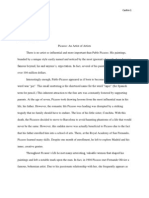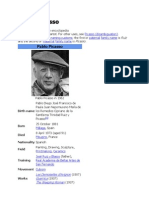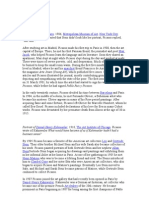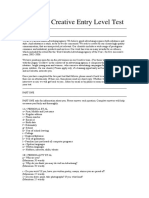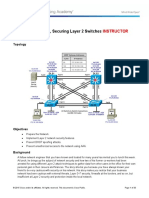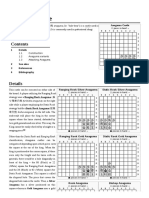EC Picasso Essay
EC Picasso Essay
Uploaded by
JennyPhoLyCopyright:
Available Formats
EC Picasso Essay
EC Picasso Essay
Uploaded by
JennyPhoLyOriginal Description:
Copyright
Available Formats
Share this document
Did you find this document useful?
Is this content inappropriate?
Copyright:
Available Formats
EC Picasso Essay
EC Picasso Essay
Uploaded by
JennyPhoLyCopyright:
Available Formats
Jennifer Ly
Pablo Picasso Essay
Pablo Picasso is one of the most famous artists of history. His was
widely well-known back then, and today for his intriguing
masterpieces. His real name is Pablo Diego José Francisco de Paula
Juan Nepomuceno María de los Remedios Cipriano de la Santísima
Trinidad Martyr Patricio Clito Ruiz y Picasso. His traditional name
honored saints and his parents. He was born in October 25, 1881 in
Malaga, Spain. He was the eldest of two younger sisters, Lola (born in
1884) and Conchita (born in 1887). Due to Diphtheria, Conchita died at
the age of seven.
His father was also a painter himself, and a professor of art at the
School of Crafts. Their generations were very artistic. Picasso had early
teachings from his father in figure drawing and painting. His father
could see Picasso’s talent and took many opportunities for his son in
the art world. He was put into and accepted in advanced classes at the
age of 13. Picasso, still at a young age, was sent to Madirds Royal
Academy of San Fernando. In 1897, at the age of 16, he set out on his
own. His conflicts of accepting formal instructions led him to quit
taking classes soon after his enrollment. But, that did not stop Picasso
from doing artworks. While in Madrid, he was inspired by other
artworks, such as the works of El Greco. In inspiration, he also studied
the arts.
Into the Art World
After studying art in Madrid, Picasso went to Paris in 1900. Back
then, Paris was known as the art capital of Europe. Arriving in Paris, he
made a new companion, Max Jacob. Max Jacob was a journalist and
poet. Max and Picasso shared an apartment, where Picasso had to burn
many of his drawings to keep the small room warm.
Picasso had put himself out there by publishing his arts in a
magazine Arte Joven (Young Art), which published five issues. He
started signing his artworks with simply the name Picasso, for before
he would signature Pablo Ruiz y Picasso. By 1905, people like Leo and
Gertrude Stein, American art collectors, started acknowledging
Picasso’s artwork. On a roll, the Steins introduced him to Claribel Cone
and her sister Etta who were American art collectors. They, too, started
collecting Picasso’s art. In 1907 Picasso joined the art gallery that was
lately opened over in Paris by Daniel-Henry Kahnweiler.
Love Behind His Art
Even an artist can have his own personal life, right? Picasso was not
only talented in art, but he was a very charming man, and multiple
wives or primary partners in his life. He was married twice and had four
children from three different mothers.
In the summer of 1918, Picasso married Ogla Khokhlova, a ballerina,
and they had their honeymoon in the villa near Biarritz of the dazzling
Chilean art patron Eugenia Errazuriz. Khohklova had helped him get
into a higher society to get his artworks spread. They had a son Paulo
(February 4, 1921 – June 5, 1975). In 1927, he had a secret affair with
17-year old Marie Therese Walter and his marriage with Ogla soon
ended. But they did not have a divorce because Picasso did not want
Olga having half of his wealth. The two were legally married until her
death in 1955. Picasso soon had a daughter with Marie-Therese. Her
name was Maia, and Marie-Therese always wished that Picasso would
marry her, but ended up hanging herself four years after Picasso’s
death. He was also a constant companion and lover with Dora Maar
and Francoise Gilot. Francoise Gilot was the mother of Claude (May 15,
1947-?) and Paloma (April 19, 1949-?). These two were also his
children. Gilot left Picasso in 1953, allegedly because of his abusive
treatment and infidelities. If you think, he couldn’t and wouldn’t have
more affairs with other women, and then you have thought wrong. He
spent the rest of his life with his wife, Jacqueline Roque.
Picasso’s Art
“Art is a lie that makes us realize the truth.”
Picasso made over 50000 artworks in his lifetime. This had him
widely known. His artworks are categorized into periods. For different
times in his life gave him different muses. The most famous and
accepted periods were: the Blue Period (1901-1904), the Rose Period
(1905-1907), the African-influenced Period (1908-1909), Analytic
Cubism (1909–1912), and Synthetic Cubism (1912–1919).
Picasso’s Blue Period included melancholy paintings in shades of blue
and blue-green, showing sadness. Many paintings were of gaunt
mothers with children date. His paintings were also influenced and
based on prostitutes and beggars. He had the same mood pervading
when he was etching the well-known The Frugal Repast, which was
based on a blind man and a sighted woman.
Picasso’s Rose Period consisted of more cheery paintings styled with
orange and pink colors, featuring many aerobatic people in France. He
met Fernande Olivier, a model for sculptors and artists. Many of his
drawings in this period were influenced or mused by her due to his
warm relationship with her.
The way Picasso drew cubism captured many people’s attention. His
artworks give inspiration to our generations of artists!
Goodbye, Picasso
For all Picasso’s years of expressing his life in is artwork, he died of old
age and other natural causes. On his funeral, his widowed wife did not
allow his children, Claude and Paloma, come. In depression, Jacqueline
Roque shot herself after her husband’s death. Picasso may be gone,
but his masterpieces live on.
You might also like
- Pablo Picasso Printit BiographyDocument2 pagesPablo Picasso Printit Biographyapi-31503755No ratings yet
- H22N Series BrochureDocument2 pagesH22N Series BrochureRicardo SobralNo ratings yet
- Pablo Picasso EssayDocument3 pagesPablo Picasso EssaypurplshockNo ratings yet
- Pablo Picasso Research PaperDocument13 pagesPablo Picasso Research PaperAadil Malik100% (1)
- 2001 A Space Odyssey AnalysisDocument56 pages2001 A Space Odyssey AnalysisAs Veja100% (1)
- The Use of Colour in Cinematography Storytelling Genre PDFDocument74 pagesThe Use of Colour in Cinematography Storytelling Genre PDFmutableS100% (3)
- Answer Key - English IV - Recuperacion.2016.01Document7 pagesAnswer Key - English IV - Recuperacion.2016.01raco50% (4)
- Bodyweight Sports TrainingDocument56 pagesBodyweight Sports TrainingJoshp3c100% (18)
- Epic Mickey - PrimaDocument288 pagesEpic Mickey - PrimaJodi BaileyNo ratings yet
- Pablo Picasso (English)Document16 pagesPablo Picasso (English)Prasteisa Citra Ayuning TiasNo ratings yet
- PicasooDocument13 pagesPicasoosandramar14No ratings yet
- Pablo Picasso's Confusing Art - Art History Textbook | Children's Art, Music & Photography BooksFrom EverandPablo Picasso's Confusing Art - Art History Textbook | Children's Art, Music & Photography BooksNo ratings yet
- Pablo PicassoDocument22 pagesPablo PicassosubirNo ratings yet
- Pablo PicassoDocument20 pagesPablo PicassoAbdu AmenukalNo ratings yet
- Pablo Picasso - WikipediaDocument131 pagesPablo Picasso - WikipediaGrace CerioNo ratings yet
- Pablo PicassoDocument18 pagesPablo PicassoNHNo ratings yet
- Pablo PicassoDocument10 pagesPablo PicassoPerse11No ratings yet
- Personal LifeDocument3 pagesPersonal LifeArkle_Lanz_4602No ratings yet
- Picasso: 20 CenturyDocument3 pagesPicasso: 20 CenturyRay DevlinNo ratings yet
- Walt Disney: A Short BiographyDocument4 pagesWalt Disney: A Short BiographySu HandokoNo ratings yet
- To Do 1) : Pablo PicassoDocument4 pagesTo Do 1) : Pablo PicassoJesus David Sendoya VargasNo ratings yet
- Pablo PicassoDocument4 pagesPablo PicassoJackie BoydNo ratings yet
- PablopicassoartstudyDocument4 pagesPablopicassoartstudyapi-352746538No ratings yet
- Pablo Picasso: WomanDocument3 pagesPablo Picasso: WomanSusana GutierrezNo ratings yet
- Pablo PicassoDocument2 pagesPablo Picassoapi-276061250No ratings yet
- Pablo Picasso From WikipediaDocument3 pagesPablo Picasso From WikipediaLilyNo ratings yet
- Pablo Picasso AttunementDocument7 pagesPablo Picasso Attunementelementalreiki100% (1)
- CubismDocument47 pagesCubismAshley Brian MoralesNo ratings yet
- Pablo PicassoDocument22 pagesPablo PicassoChristySindhujaNo ratings yet
- Picasso Quotations1 PDFDocument48 pagesPicasso Quotations1 PDFKranthi FictionNo ratings yet
- Art Report - Pablo PicassoDocument3 pagesArt Report - Pablo Picassoapi-254130085No ratings yet
- PicassoDocument3 pagesPicassoAurel DeduNo ratings yet
- Pablo Picasso Biografia y ObraDocument11 pagesPablo Picasso Biografia y ObraAndreaVangNo ratings yet
- Pablo PicassoDocument16 pagesPablo Picassoapi-193496952No ratings yet
- Pablo Picasso: Stages of His LifeDocument6 pagesPablo Picasso: Stages of His LifeEtienne Debs0% (1)
- DocumentcDocument3 pagesDocumentcajnsfashionltd2010No ratings yet
- Pablo Picasso - Quotes Collection: Biography, Achievements And Life LessonsFrom EverandPablo Picasso - Quotes Collection: Biography, Achievements And Life LessonsNo ratings yet
- Pablo PicassoDocument1 pagePablo Picassomynamejeffwry1No ratings yet
- Pablo PicassoDocument3 pagesPablo Picassoeszter09tothNo ratings yet
- Pablopicasso Portfolio3Document4 pagesPablopicasso Portfolio3api-352757193No ratings yet
- SpanishartistDocument4 pagesSpanishartistapi-352757163No ratings yet
- Early LifeDocument1 pageEarly LifeOlgaCiorbaNo ratings yet
- Pablo Picasso: BiographyDocument45 pagesPablo Picasso: BiographyMD.RASED ISLAM RASEL100% (1)
- Pablo Picasso Print - BiographyDocument3 pagesPablo Picasso Print - BiographyFREIMUZIC100% (1)
- Pablo PicassoDocument6 pagesPablo PicassoTahseena WaseemNo ratings yet
- Pablo Picasso (25 October 1881 - 8 April 1973)Document2 pagesPablo Picasso (25 October 1881 - 8 April 1973)Deb BonNo ratings yet
- IntroDocument6 pagesIntroapi-259784523No ratings yet
- Pablo PicassoDocument1 pagePablo PicassoLizZelencichNo ratings yet
- Les Demoiselles D'avignon Guernica: Pablo Picasso (Document1 pageLes Demoiselles D'avignon Guernica: Pablo Picasso (suchi ravaliaNo ratings yet
- Picasso's Blue Period - WikipediaDocument24 pagesPicasso's Blue Period - WikipediaDinesh RajputNo ratings yet
- Pablo Ruiz Picasso (25 October 1881 - 8 April 1973) WasDocument2 pagesPablo Ruiz Picasso (25 October 1881 - 8 April 1973) WasRashid HakeemNo ratings yet
- PM Picasso Eng FinalDocument13 pagesPM Picasso Eng FinalberNo ratings yet
- Wifredo Lam: 2 Career in EuropeDocument6 pagesWifredo Lam: 2 Career in EuropearetegriegaNo ratings yet
- Fine Arts Reserch 1Document4 pagesFine Arts Reserch 1Hady MagedNo ratings yet
- Milena Pavlović Barili Seminar PaperDocument5 pagesMilena Pavlović Barili Seminar PaperNemanja StojakovićNo ratings yet
- Gaughin in TahitiDocument13 pagesGaughin in TahitijoecerfNo ratings yet
- Artistpablopicasso 3 RdprojectspanishDocument4 pagesArtistpablopicasso 3 Rdprojectspanishapi-352746470No ratings yet
- Virginia Woolf:: Marguerite YourcenarDocument3 pagesVirginia Woolf:: Marguerite YourcenarveronicaNo ratings yet
- NHD Pablo PicassoDocument6 pagesNHD Pablo Picassoapi-482326353No ratings yet
- ARTAHUM Report CoverDocument15 pagesARTAHUM Report CoverGeloNo ratings yet
- A Short BiographyDocument1 pageA Short BiographyFam PerezNo ratings yet
- Picasso's Erotic Code - Vanity FairDocument17 pagesPicasso's Erotic Code - Vanity FairOfuokwu GeraldNo ratings yet
- SECTION A: Guided Writing: You Are Advised To Spend About 40 Minutes On This QuestionDocument4 pagesSECTION A: Guided Writing: You Are Advised To Spend About 40 Minutes On This QuestionKhairiah YusofNo ratings yet
- Response Creative Entry Level TestDocument3 pagesResponse Creative Entry Level TestBitadru GhoshNo ratings yet
- Beed Business DatabseDocument4 pagesBeed Business DatabseEclat MultiNo ratings yet
- Lenovo B460 - V460 Wistron LA46 UMA 09922-1 Rev1 SchematicDocument48 pagesLenovo B460 - V460 Wistron LA46 UMA 09922-1 Rev1 Schematicnasir khan100% (1)
- DX-D 30c: Digital Wireless DetectorDocument4 pagesDX-D 30c: Digital Wireless DetectorDavid MartínezNo ratings yet
- Best Deal Price List PDFDocument2 pagesBest Deal Price List PDFNS Paliwal100% (4)
- Chapter 10 Lab 10-1, Securing Layer 2 Switches: InstructorDocument33 pagesChapter 10 Lab 10-1, Securing Layer 2 Switches: InstructorSantiagoNo ratings yet
- The Two Thugs: Literature LiteratureDocument2 pagesThe Two Thugs: Literature LiteratureKashmir Media ServiceNo ratings yet
- FA 30 - LE 2 - Reviewer - FinalDocument71 pagesFA 30 - LE 2 - Reviewer - FinalCamille BernardezNo ratings yet
- Modal VerbsDocument7 pagesModal VerbsceliacabeNo ratings yet
- Fantasy CampaignDocument9 pagesFantasy CampaignIsrael AbelNo ratings yet
- B PDFDocument24 pagesB PDFArawnNo ratings yet
- The Future of ArmaniDocument9 pagesThe Future of ArmaniHeena KhatriNo ratings yet
- South Dakota 2016 Hunting and Trapping HandbookDocument68 pagesSouth Dakota 2016 Hunting and Trapping HandbookAmmoLand Shooting Sports NewsNo ratings yet
- Prisa Brochure Final - 03Document12 pagesPrisa Brochure Final - 03shankbittuNo ratings yet
- Anaguma CastleDocument5 pagesAnaguma CastleStefano ProfeNo ratings yet
- Lab Manual: B.Sc. HHM/RCM/REM - 1Document13 pagesLab Manual: B.Sc. HHM/RCM/REM - 1DrHimanshu MalikNo ratings yet
- Chef's Flavour: Restaurant & CaterersDocument8 pagesChef's Flavour: Restaurant & CaterersAfanti NasruddinNo ratings yet
- Metron SpO2 Simulator - User ManualDocument20 pagesMetron SpO2 Simulator - User ManualMigue ZabaletaNo ratings yet
- ForrsDocument5 pagesForrsThalles Da SilvaNo ratings yet
- Saving Throws Ability Score: Character DetailsDocument2 pagesSaving Throws Ability Score: Character DetailsJoão vitor buenoNo ratings yet
- A Reinvention of Realism in Raymond CarverDocument17 pagesA Reinvention of Realism in Raymond Carverrociogordon100% (1)
- Progress Test 12Document2 pagesProgress Test 12Milan100% (1)
- Paper Towns Choice BoardDocument2 pagesPaper Towns Choice Boardapi-454012608No ratings yet


